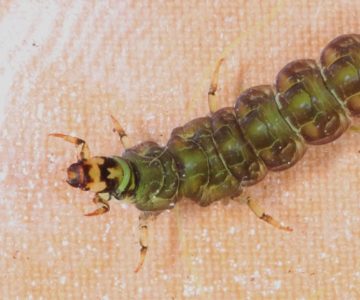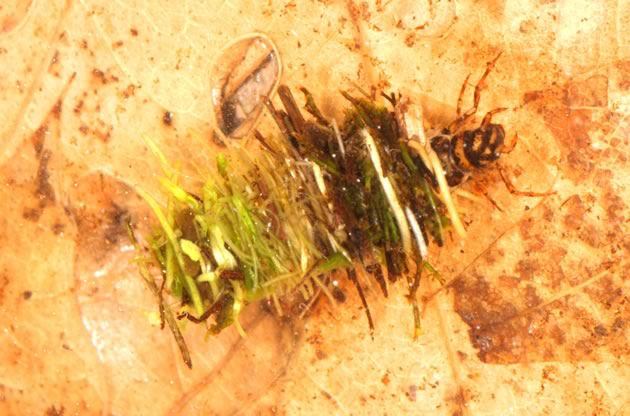Caddisflies
French artist Hubert Duprat capitalized on this in the 1980s by supplying caddisflies with flecks of gold and tiny precious stones.

Mixed materials
Creatures bizarre and wondrous teem in woodland ponds – ingredients of a rich biotic soup. Many delightful hours can be spent investigating this bustle of life. Be prepared to be amazed.
If you think I exaggerate, take a look at the images on this page. Caddisfly larvae are among the most fascinating pond inhabitants. These beguiling grubs are master homebuilders. They glue all and sundry into elaborate homes called “cases” that serve to protect their soft bodies.
Different species of caddisfly have preferences for particular building materials, with twigs, bark, stones, shells, leaves and plant fibers commonly used. But if deprived of these favoured materials, caddisfly larvae will make due with whatever is available.
Caddisfly jewelry
French artist Hubert Duprat capitalized on this in the 1980s by supplying caddisflies with flecks of gold and tiny precious stones. The result? Stunning pieces of organically constructed jewelry. Other artists and entrepreneurs have followed Duprat’s lead and caddisfly cases are now incorporated into earrings, bracelets, necklaces and pendants.
Like human cultures, different caddisfly species have developed unique basic designs for their homes. Some arrange pieces of pond detritus in shish-kebob fashion, others build precise conical structures out of pebbles or create cylinders out of plant material. Some of the pictures accompanying this blog are of “log cabin” caddisfly cases – the derivation of the name is obvious.
These remarkable caddisfly homes are easy to find and observe in the spring, before their larval occupants transform into gossamer-winged adults. Simply watch the bottom of a pond and wait for movement. Soon you should see caddisfly cases aplenty, being pulled along by their makers.
A small dip net, a plastic container and a magnifying glass will permit close inspection. It’s fun to figure out the materials used in construction and to search for different designs created by these diminutive aquatic artisans.
More Info
For more information about Hubert Duprat and photos of his caddisfly work, see http://www.cabinetmagazine.org/issues/25/duprat.php.
Related Stories

Benthic Invertebrates
Jul 3, 2019 | | Notes from the WildThe abundance of these aquatic larvae in our streams and rivers is a good thing.

Vernal Pools
Mar 20, 2017 | | EnvironmentThese fleeting spring wetlands are factories of biodiversity. Unusual winters threaten vernal pools, as do hot, dry summers.













